“Manufacturing buyers demand valuable expertise, not more promotional noise. Content marketing that educates first and promotes second builds relationships ripe for revenue.”
At DataDab, we help ambitious manufacturing brands level up growth with smart digital transformations. Yet we know even advanced teams still find industrial sectors to be unique beasts posing complex challenges in the marketing realm. Navigating long technology sales cycles, fragmented decision units, and conservative cultures demands a creative, decentralized approach.

In this comprehensive guide, we’ll walk through the proven frameworks we repeatedly leverage to drive results and adoption for manufacturers actively staking digital-first competitive positioning. You’ll discover how our teams craft cohesive strategies that unify brand development aspirations with hard revenue accountability. We demystify how to dissect convoluted purchase journeys prevalent in sourcing capital solutions while arming you with inside tips on navigating the personas involved for enterprise impact.
We’re thrilled to condense decades of hands-on experience catalyzing manufacturing leadership through intuitive marketing into this playbook, distilling need-to-know lessons for your own industrial innovation quests. Let’s get started.
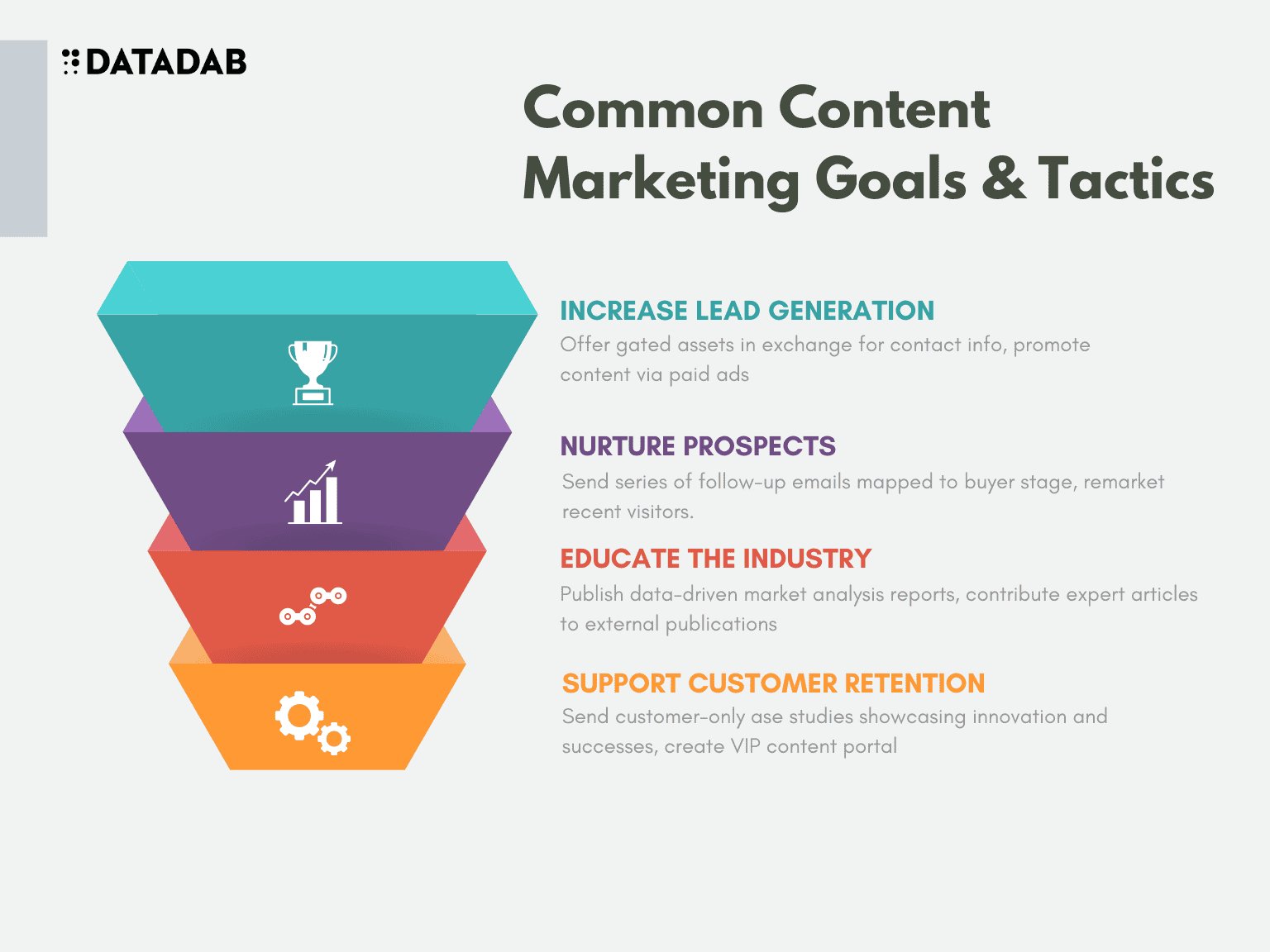
Crafting a Custom Marketing Plan for Manufacturers
An overarching marketing plan tailored specifically to the B2B manufacturing sphere is the foundation for success. This involves careful steps to develop comprehensive strategies coupled with the agility to adapt approaches over time.
Steps to Develop a Comprehensive Marketing Strategy
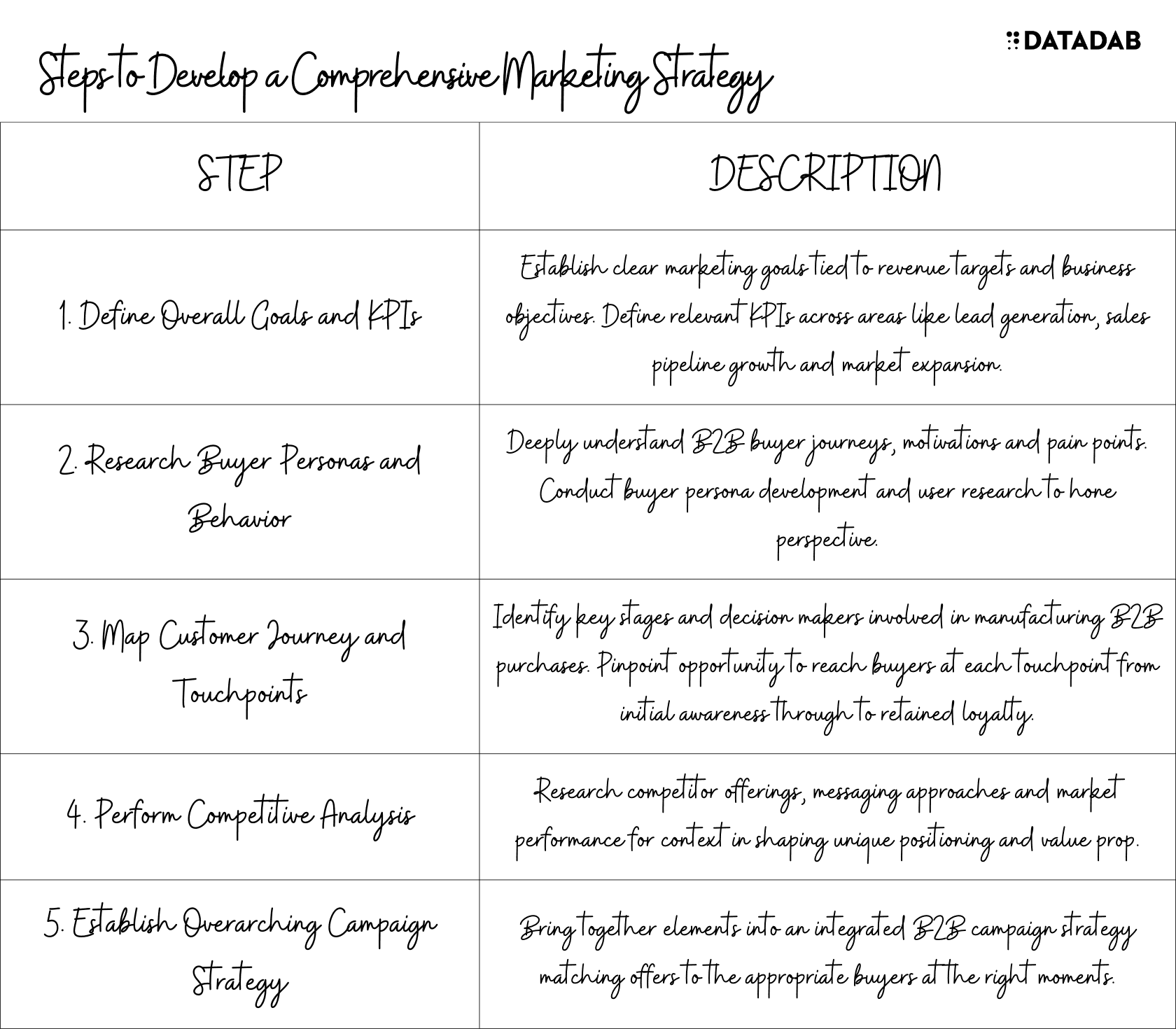
Balancing Short-Term Goals and Long-Term Vision
The most effective marketing leaders pair strategic big picture thinking with tactical optimization to drive both immediate ROI and ambitious future growth.
Table below provides an example framework for balancing short and long-term horizons in an integrated fashion:
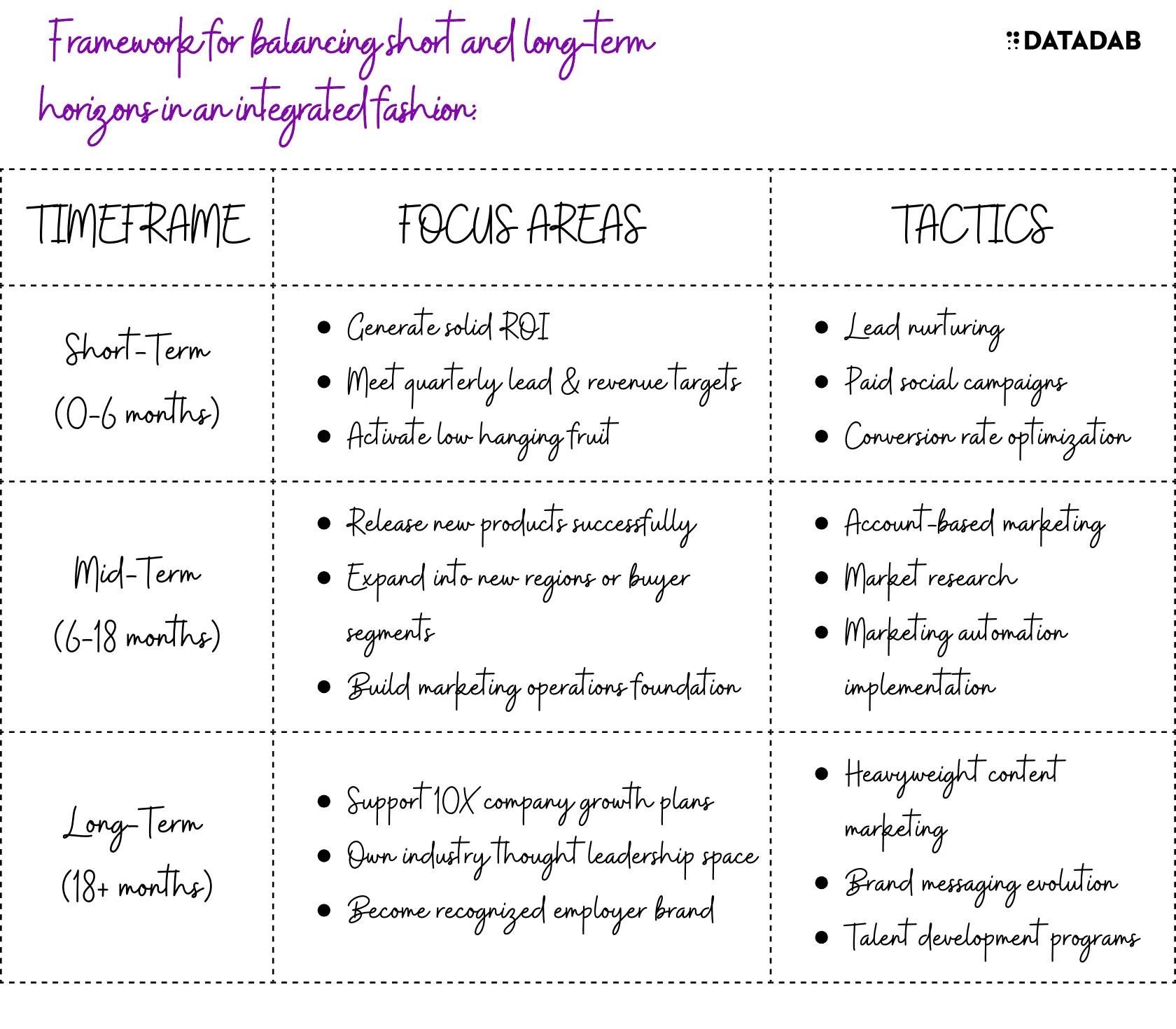
With an integrated strategic marketing plan in place encompassing both short-term ROI wins and long-term ambitious visions for growth, manufacturing marketers can thrive through even the most turbulent business climates.
![What's Happening in Manufacturing Content Marketing [New Research]](https://contentmarketinginstitute.com/wp-content/uploads/2019/11/2020_Manufacturing_TotalContentCreated.jpg)
The Power of Content Marketing in B2B Manufacturing
Targeted content marketing represents an immense opportunity for manufacturing from driving brand awareness to nurturing prospects and retaining loyal clients. Developing stellar content informs and engages customers across every step of their journey.
Developing Engaging and Informative Content
Manufacturing content must strike a careful balance between educational expertise and compelling engagement. Some best practices include:
- Offer specific value propositions upfront, answering buyer questions
- Blend text, visuals, and multimedia for varied content formats
- Share authentic behind-the-scenes insights into processes
- Promote user-generated content from clients showcasing solutions
- Ensure mobile-friendly design and consumption

Utilizing Case Studies and White papers Effectively
Two particularly impactful content formats for manufacturing include case studies showcasing client success stories and authoritative white papers educating prospects.
Case studies put a tangible face on abstract solutions, build trust, and provide critical social proof for purchase decisions. Develop succinct yet compelling narratives highlighting the problem, solution and business impact.
Whitepapers enable in-depth education on key industry topics, manufacturing capabilities and technical processes. They position firms as forward-thinking thought leaders. Keep whitepaper content nuanced, leverage visual explanations, and promote via gated access.
Getting content marketing right lays the groundwork for the entire buyer journey, and case studies combined with whitepapers represent secret weapons for manufacturing lead generation when executed correctly.
![Digital Transformation in Manufacturing [Concepts, Technologies, Trends] | SaM Solutions](https://www.sam-solutions.com/blog/wp-content/uploads/2021/06/Benefits-digital-transformation-in-manufacturing-image-1-min.png)
Digital Transformation in Marketing
Digital innovation presents manufacturing marketing teams with automation capabilities to work smarter amidst growing complexity. New martech tools also enable advanced targeting and messaging personalization powered by data.
Embracing Automation and AI in Marketing Efforts
Sales and marketing workflows often encompass an array of repetitive and data-intensive processes that automation and AI are well-suited to optimize. This provides opportunities to:
- Automate lead scoring protocols to identify accounts with the highest potential
- Build machine learning models that predict future churn likelihood so at-risk clients can be proactively saved
- Automatically match incoming leads to the best-fit sales reps based on various account criteria
- Generate personalized messaging at scale across multichannel campaigns
The Role of CRM and Marketing Automation Tools
Robust customer relationship management (CRM) systems centralize all prospect and client data to enable real-time access and informed decisions powered by analytics. Marketing automation tools built on CRM take capabilities even further with functionality to:
- Orchestrate tailored nurture streams for inbound leads
- Define complex lifecycle workflows mapped to buyer journeys
- Trigger automated tasks and messaging triggered by prospect behaviors
Investing in the right martech stack makes efficient operations, precise targeting, and impactful ROI achievable at scale. The capabilities transform marketing from isolated campaigns to fully integrated lifecycle journeys.
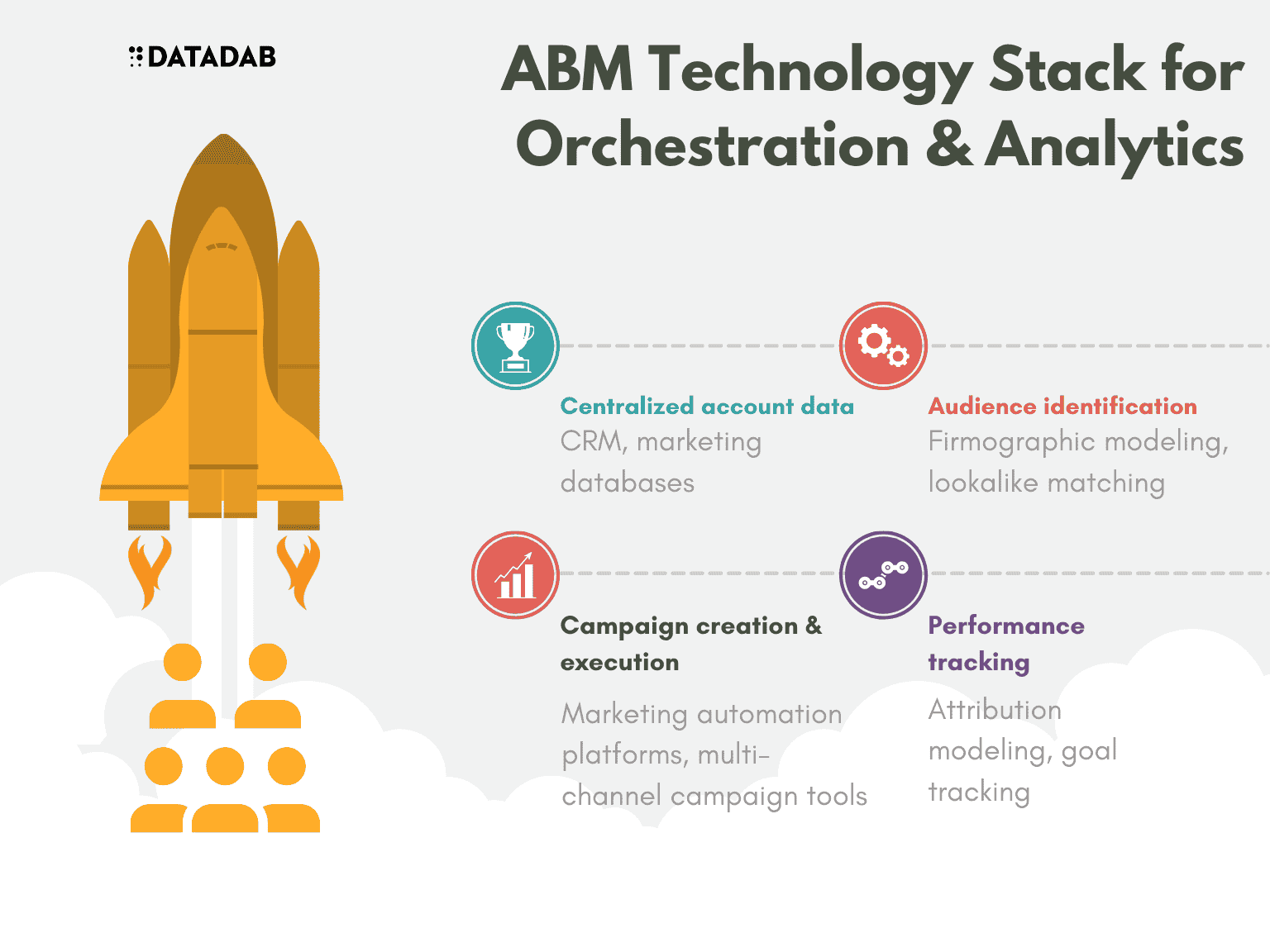
Account-Based Marketing (ABM) for Precision Targeting
Another way manufacturing marketers can level up is adopting an account-based approach directed at high-value accounts vs scattered efforts aimed at broad audiences. ABM enables remarkable precision, uncovering exactly how key accounts research solutions and tailoring messaging to accelerate their paths to purchase.
Implementing ABM for High-Value Manufacturing Clients
Winning new business from large manufacturing enterprises demands in-depth understanding of key decision-makers, their priorities and motivations. An account-based strategy built on research and human engagement outperforms any spray-and-pray tactic that simply casts a wide net blindly hoping for a few bites.
The table below showcases viable steps for executing effective account-based marketing across tier-one manufacturing accounts:
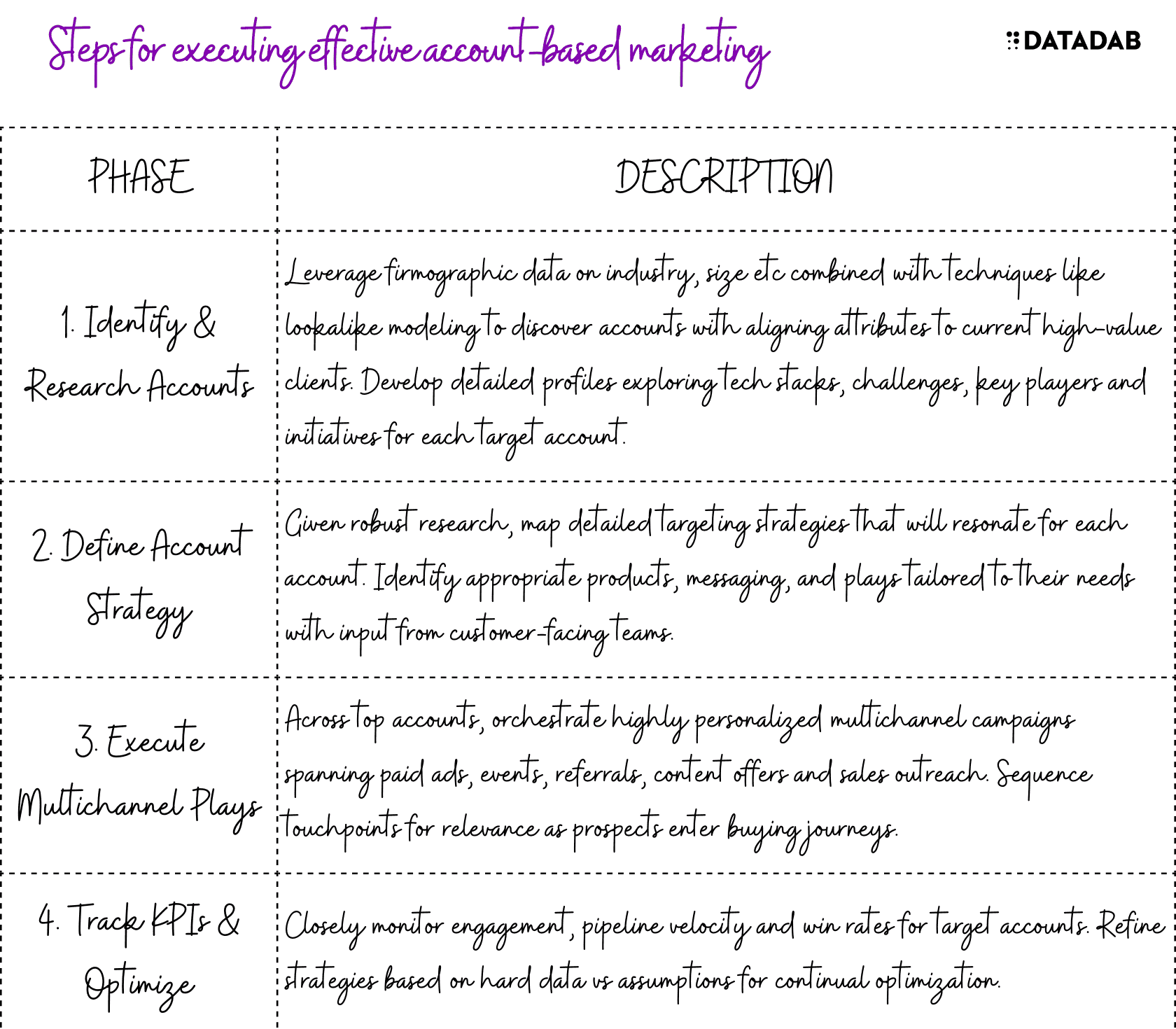
ABM is a virtuous cycle where more data continually refines targeting and messaging relevance to increase conversions. It also aligns sales and marketing around named target accounts to coordinate highly tailored pursuit.
Best Practices for ABM Success
Select best practices that enable ABM programs to deliver wildly effective growth for manufacturing include:
- Gain executive buy-in with hard data on potential revenue impact
- Allow at least 6 months for early wins given longer sales cycles
- Maintain rigor segmenting and profiling target accounts
- Build multidisciplinary pursuit teams encompassing perspectives from sales, marketing, customer success and leadership
- Invest in quality creative, content and digital experiences that align to account needs
- Persistently analyze campaign performance and trends to sharpen efforts
With the right foundations and sharp execution in place, savvy manufacturing marketers find ABM transforms from abstract concept to reliable revenue engine over time.
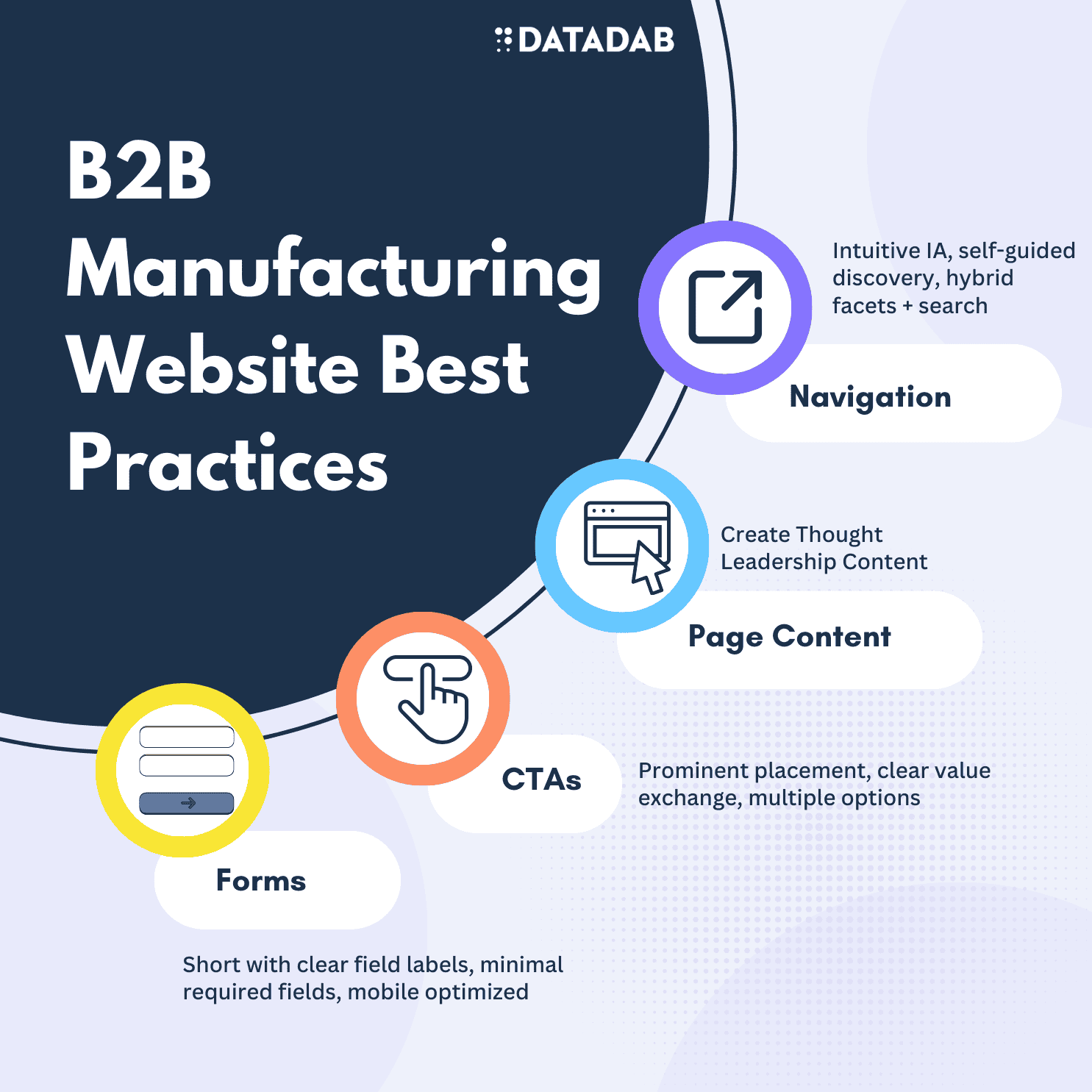
Building a Strong Online Presence: Website and SEO Best Practices
While many B2B buyers today self-educate online long before engaging sales teams directly, subpar website experiences hinder manufacturers from capitalizing on this demand. Investing in SEO visibility, informational architecture and conversion rate optimization is imperative.
Designing an Effective B2B Manufacturing Website
A modern website remains the hub of all marketing efforts, and manufacturing sites require tailored elements for success including:
- Robust product pages detailing capabilities, applications, integrations, supported materials and technical specifications
- Project portfolio case studies that humanize abstract solutions with real-world examples and ROI business impacts
- Smart routing and contact options that enable prospects to conveniently take next steps whether chatting with experts, requesting pricing or signing up for demos
- Responsive pages equally optimized for desktop and mobile usage critical for on-the-go buyer research and decisions
SEO Strategies for Improved Online Visibility
Employing technical and content-focused SEO best practices improves discoverability and rankings so manufacturing websites appear higher in search engine results for relevant buyer queries:
- Conduct keyword research to shape metadata, URLs, headings and content around highly searched industry terms and commercial searcher intents
- Optimize page speed through image compression, simplified code, browser caching and other optimizations to improve user experience
- Generate regular blog content covering topics manufacturing prospects commonly explore to build domain authority and regularly showcase expertise
- Earn backlinks via guest articles on reputable publications to signal quality content to search algorithms
With empowered self-guided buying journeys now the norm in B2B spheres, manufacturers must build online destinations that engage and inform at every turn while also appearing at the top of relevant Google searches.
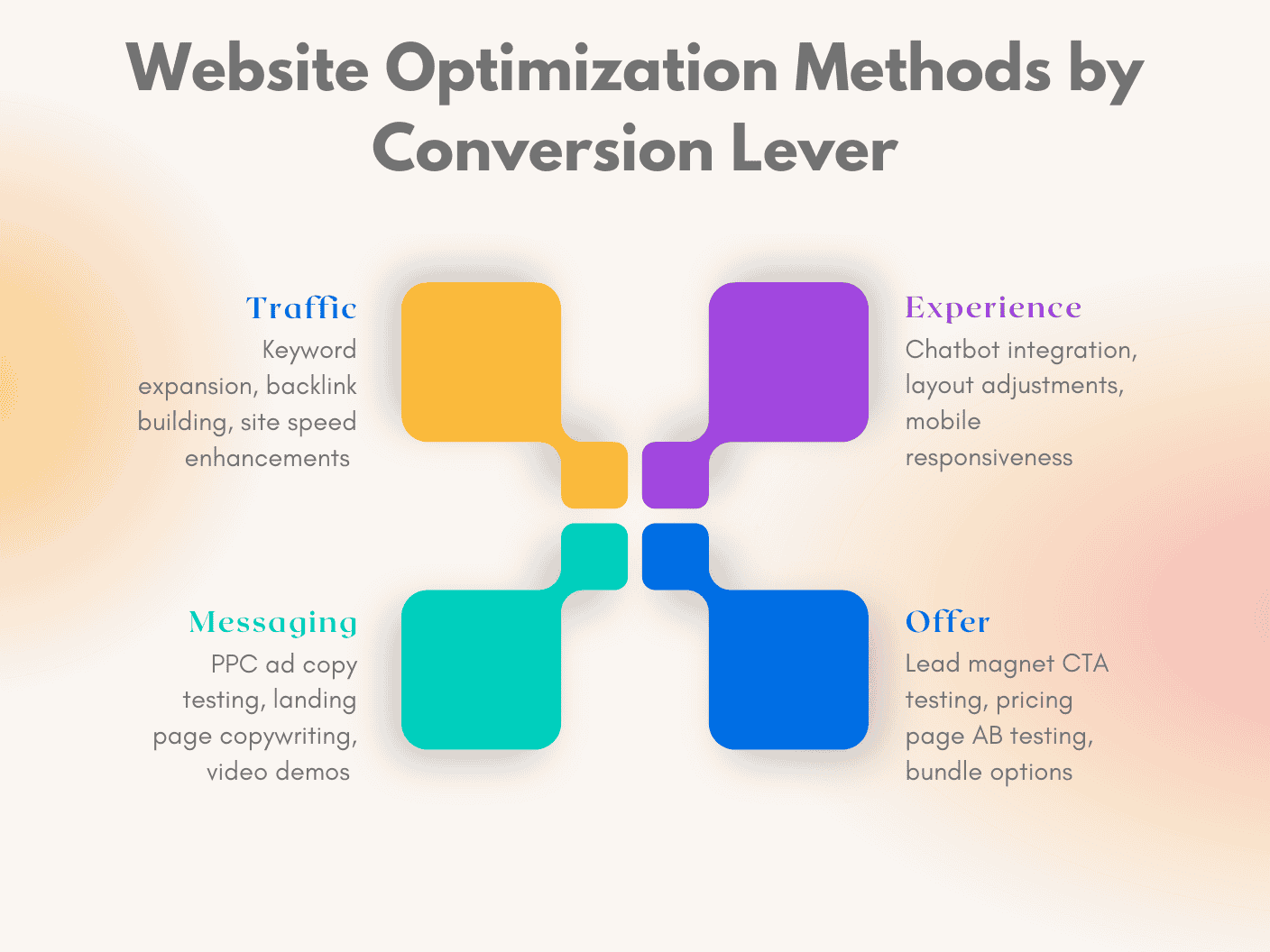
Nurturing Leads and Converting Prospects
The last mile of marketing encompasses nurturing promising leads until sales can effectively take over while also removing friction across the prospect journey to drive conversions. The effectiveness of securing meetings and closing deals determines ROI.
Effective Lead Nurturing Tactics and Sales Alignment
Lead nurturing via ongoing valuable communications represents a key opportunity to educate prospects until sales is ready to take the reins. Core aspects include:
- Outbound content shares matching assets to individual interests signal ongoing value
- Remarketing ads keep brand exposure high as prospects visit other sites
- Lead scoring helps marketing qualify and prioritize the ripest sales opportunities
- Closely collaborate with sales to hand off leads at the ideal timing
With tight alignment between sales teams, marketing balances pipeline generation without overburdening reps with low-quality leads.
Conversion Optimization Techniques for Manufacturers
Various conversion optimization tactics apply for manufacturing marketers from landing page enhancements to smoother payment integrations.
For example, advanced website testing methodology evaluates elements like layouts, copy variants, visual themes, content offers and calls-to-action to determine what maximizes desired prospect behaviors. Testing then drives continual site evolution.
Ongoing conversion rate optimization coupled with frictionless buying experiences also builds revenue steam engines primed for sales team success.
Conclusion: Staying Agile in a Dynamic Manufacturing Market
Modern manufacturing spans volatile supply chains, technological disruption and buyer behavior shifts — all dynamics demanding marketing to play offense and stay agile.
This guide outlined next-level marketing areas from tailored segmentation approaches to conversion-focused execution that enable manufacturers to thrive amid turbulence.
Firms taking an integrated approach build long-run competitive advantage and outpace industrial peers. By leveraging the mix of strategies here spanning targeted account-based tactics, conversion-optimized sites, and multifaceted automation, manufacturing marketing teams can confidently deliver growth regardless of external changes in the years ahead.
FAQ
1. How are marketing goals shifting for manufacturing leaders and teams in the current digital climate?
Past decades had industrial marketing teams almost exclusively focused on supporting sales pipeline via tradeshow lead generation and fragmented email blasts centered on product feature awareness. However, leaders now expect modern marketing to drive holistic digital transformation encompassing brand positioning, community engagement, lifecycle optimization, and data-driven everything. As millennials proliferate decision-making roles, even manufacturing purchasing expands beyond utilitarian needs into emotional connections. This demands integrated strategies that balance commercial outcomes, experiences, and loftier purposes. Marketing's charter expanded from demand gen to digital orchestration.
2. Why should manufacturers care about traditional brand marketing, and how can they activate it digitally?
Brand marketing establishes emotional connections that pay dividends, securing customer loyalty and advocacy. Manufacturing purchases frequently follow months of meticulous work, weighing endless technical qualifications. Hence, brands that inspire beyond specs earn stickiness and win on factors beyond price or feature checklists alone. Digital channels enable scalable 1:1 brand building via personalized content, community cultivation, and immersive buying journeys that resonate individually - a clear competitive advantage.
3. What specific technologies or software platforms show the most promise for manufacturers aiming to modernize marketing operations?
Marketing technologist stacks now anchor successful transformation. Players that consolidate enterprise-ready CRM databases, creative campaign execution tools, and insights-driven automation in unified ecosystems accelerate growth while optimizing budget efficiency. Adobe, Salesforce, and Oracle lead categories across account-based orchestration, persona-driven journeys, and system integration. Investments focused on consolidating insights from intent signals, existing tech stacks, and online behaviors tailor manufacturing engagement, directing precious resources only to buyers most likely to demonstrate consideration signals.
4. Why is account-based marketing gaining so much attention recently and what does it entail for complex manufacturers?
Account-based marketing focuses energy solely on targeted blueprint accounts rather than diffuse general awareness plays. For manufacturers serving concentrated customers amid lengthy sales cycles, ABM efficiency gains prove immense, allowing coordination across marketing, sales, and customer success teams. Orchestrating tailored multichannel campaigns from personalized advertising to value-forward content across buying committees earns engagement for manufacturers before competitors even qualify lead interest.
5. What types of content formats connect best with manufacturing buyer committees flooded with sales overtures?
Manufacturing content only earns engagement when addressing specifics around use applications, operational challenges, and technical specifications. Buyers tune out generic thought leadership or overtly promotional materials lacking substance. Case studies exploring real-world implementations, data-rich analytical reports demonstrating ROI opportunities by industry, and peer interview articles enable personal connections without forcing product pitches. Video factory walkthroughs also earn attention if they illustrate capabilities. Format matters less than relevance depth matching buyer needs.
6. Why is marketing and sales alignment instrumental for improving manufacturing funnel velocity, and what cultural obstacles impede this?
Lack of coordination between sales and marketing directly reduces conversion effectiveness and reporting credibility to executive teams. However, rigid structures siloing teams into demand gen, pipeline management, and closing prevent insights sharing that bridges molecular view of accounts with tailored targeting. Outdated individual quotas also sometimes incent less than collaborative approaches. Still, when marketing automates hand-offs to sales integrating systems into singular sequencing, results increase dramatically via transparent accountability.
7. How could AI and machine learning augment manufacturing marketing and sales processes?
Both AI and machine learning introduce automation efficiencies at a scale that personalized sales methodologies long promised but rarely actualized without immense manual effort. Building algorithms that automatically analyze accounts to detect signals of consideration momentum helps organizations double down on hot prospects amid lengthy buying cycles - getting to the right people at the right times. Predictive lead scoring also qualifies inbound interest level accurately without extensive manual reviews to align follow-up urgency appropriately.
8. Which metrics and KPIs should be used for measuring manufacturing funnel and campaign performance - why?
Convenient metrics like form fills, or ad clicks fail to capture true influence generating enterprise deals. Commercial advancement matters most. Is awareness shifting from cold brands to your products after early content syndication pushes? Do technically oriented mid-funnel assets enjoy greater average consumption best, indicating solidification as an evaluated option? Ultimately, sales pipeline velocity, average deal sizes, and win rates by targeted account segments paint holistic pictures. Marketing's North Star centers on fueling data centralization that powers advanced analytics for smarter commercial decisions by all teams.
9. How can manufacturing organizations optimize their websites for higher conversion performance?
Technical site enhancements like mobile responsiveness, reliable uptime and frictionless user flows remove obstacles to conversion while copy, imagery and content prioritized for SEO visibility drive discovery momentum. Testing product page layouts against customer research data further optimize for usability tailoring to manufacturing buyers. Integrating premium gated content access in return for contact info balances educational needs with pipeline growth. Prominent chat and support widgets build relationships at scale as well. The combination of conversion-focused design and enterprise authority Sept manufacturers top-of-mind.
10. Why is unified attribution modeling an emerging priority for proving manufacturing marketing's impact and how is this achieved?
Sophisticated organizations now mandate justified ROI on all activities - including branding and awareness, historically difficult to quantify - especially given prolonged technology sales journeys. Multi-touch attribution combines behavioral signals like web clicks, content downloads, and email opens with traditional pipeline contributions and applies machine learning algorithms to assign appropriate value weightings to each. This enables accurate modeling of conversion influence over 6, 12, and 18-month horizons aligning to average sales cycles. Marketers who avoid attribution technology risk losing credibility and access to leadership priorities. Conveying measurable impact now requires tech fluency, unifying fragmented data trails.






